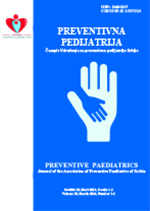SCREENING OF DEPRESSIVE AND ANXIETY DISORDERS IN ADOLESCENTS WITH EPILEPSY
DOI:
https://doi.org/10.46793/PP241127002RKeywords:
screening, depression, anxiety, adolescents, epilepsyAbstract
Epilepsy is the most common chronic neurological disorder in childhood, negatively affecting the physical, psychological, and social functioning of those affected and their families. Around 21-60% of adolescents with epilepsy develop mental disorders, with the most common being depressive and anxiety disorders which significantly impact quality of life. Depression increases the risk of behavioral problems, substance abuse, and other social issues. Anxiety disorders, such as panic disorder and social phobia, are also common among adolescents with epilepsy, with the possibility of developing more severe psychopathological conditions. These disorders often go unrecognized and inadequately treated, increasing the risk of symptom worsening. It is important to conduct screening for depressive and anxiety symptoms in adolescents with epilepsy. The recommendation is to implement screening questionnaires for the early detection of these disorders. Early recognition of symptoms allows for proper referral to psychological treatments, which can improve patients' quality of life, compliance, and reduce the risk of disease deterioration.
References
Fisher RS, Acevedo C, Arzimanoglou A, Bogacz A, Cross JH, Elger CE, et al. ILAE official report: a practical clinical definition of epilepsy. Epilepsia. 2014;55(4):475-482. doi: 10.1111/epi.12550. PMID: 24730690.
Aaberg KM, Gunnes N, Bakken IJ, Lund Søraas C, Berntsen A, Magnus P, et al. Incidence and Prevalence of Childhood Epilepsy: A Nationwide Cohort Study. Pediatrics. 2017;139(5):e20163908. doi: 10.1542/peds.2016-3908. PMID: 28557750.
Beghi E. The Epidemiology of Epilepsy. Neuroepidemiology. 2020;54(2):185-191. doi: 10.1159/000503831. PMID: 31852003.
Forsgren L, Hauser WA, Olafsson E, Sander JW, Sillanpää M, Tomson T. Mortality of epilepsy in developed countries: a review. Epilepsia. 2005;46 Suppl 11:18-27. doi: 10.1111/j.1528-1167.2005.00403.x. PMID: 16393174.
Minardi C, Minacapelli R, Valastro P, Vasile F, Pitino S, Pavone P, et al. Epilepsy in Children: From Diagnosis to Treatment with Focus on Emergency. J Clin Med. 2019 2;8(1):39. doi: 10.3390/jcm8010039. PMID: 30609770.
Ott D, Siddarth P, Gurbani S, Koh S, Tournay A, Shields WD, et al. Behavioral disorders in pediatric epilepsy: unmet psychiatric need. Epilepsia. 2003;44(4):591-597. doi: 10.1046/j.1528-1157.2003.25002.x. PMID: 12681010.
Ekinci O, Titus JB, Rodopman AA, Berkem M, Trevathan E. Depression and anxiety in children and adolescents with epilepsy: prevalence, risk factors, and treatment. Epilepsy Behav. 2009;14(1):8-18. doi: 10.1016/j.yebeh.2008.08.015. PMID: 18804186.
Adewuya AO, Oseni SB. Impact of psychiatric morbidity on parent-rated quality of life in Nigerian adolescents with epilepsy. Epilepsy Behav. 2005;7(3):497-501. doi: 10.1016/j.yebeh.2005.07.011. PMID: 16143568.
American Psychiatric Association: Diagnostic and Statistical Manual of Mental Disorders, Fifth Edition. Arlington, VA: American Psychiatric Association; 2013. p. 155-158.
Ministarstvo zdravlja Republike Srbije. Nacionalni vodič dobre kliničke prakse za dijagnostikovanje i lečenje depresije, Beograd, 2011. p. 92-3.
Penninx BW, Pine DS, Holmes EA, Reif A. Anxiety disorders. Lancet. 2021 6;397(10277):914-927. doi: 10.1016/S0140-6736(21)00359-7. Erratum in: Lancet. 2021;397(10277):880. doi: 10.1016/S0140-6736(21)00473-6. PMID: 33581801.
Ströhle A, Gensichen J, Domschke K. The Diagnosis and Treatment of Anxiety Disorders. Dtsch Arztebl Int. 2018;155(37):611-620. doi: 10.3238/arztebl.2018.0611
Coppola G, Operto FF, Matricardi S, Verrotti A. Monitoring And Managing Depression In Adolescents With Epilepsy: Current Perspectives. Neuropsychiatr Dis Treat. 2019;15:2773-2780. doi: 10.2147/NDT.S192714. PMID: 31576132.
Dunn DW, Austin JK, Perkins SM. Prevalence of psychopathology in childhood epilepsy: categorical and dimensional measures. Dev Med Child Neurol. 2009;51(5):364-372. doi: 10.1111/j.1469-8749.2008.03172.x. PMID: 19018836.
US Preventive Services Task Force. Screening and Treatment for Major Depressive Disorder in Children and Adolescents: Recommendation Statement. Am Fam Physician 2010;82:178–179.
Wong J, Gill J, Rees G, et al. Screening for Depression in Adolescents with Epilepsy. JAMA 2020;324(24):2499-2507.
Stallwood E, Monsour A, Rodrigues C, Monga S, Terwee C, Offringa M, et al. Systematic Review: The Measurement Properties of the Children's Depression Rating Scale-Revised in Adolescents With Major Depressive Disorder. J Am Acad Child Adolesc Psychiatry. 2021;60(1):119-133. doi:10.1016/j.jaac.2020.10.009. PMID: 33130251.
Park K, Jaekal E, Yoon S, Lee SH, Choi KH. Diagnostic Utility and Psychometric Properties of the Beck Depression Inventory-II Among Korean Adults. Front Psychol. 2020 21;10:2934. doi: 10.3389/fpsyg.2019.02934. PMID: 32038360.
Behrens B, Swetlitz C, Pine DS, Pagliaccio D. The Screen for Child Anxiety Related Emotional Disorders (SCARED): Informant Discrepancy, Measurement Invariance, and Test-Retest Reliability. Child Psychiatry Hum Dev. 2019;50(3):473-482. doi: 10.1007/s10578-018-0854-0. PMID: 30460424.
Varni JW, Seid M, Rode CA. The PedsQL: measurement model for the pediatric quality of life inventory. Med Care. 1999;37(2):126-139. doi: 10.1097/00005650-199902000-00003. PMID: 10024117.
Wagner JL, Kellermann T, Mueller M, Smith G, Brooks B, Arnett A, et al. Development and validation of the NDDI-E-Y: a screening tool for depressive symptoms in pediatric epilepsy. Epilepsia. 2016;57(8):1265-1270. doi: 10.1111/epi.13446. Erratum in: Epilepsia. 2018;59(10):2004. doi: 10.1111/epi.14564. PMID: 27354177.





